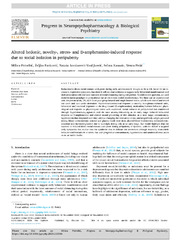Приказ основних података о документу
Altered hedonic, novelty-, stress- and D-amphetamine-induced response to due to social isolation in peripuberty
| dc.creator | Potrebić, Milica | |
| dc.creator | Pavković, Željko | |
| dc.creator | Lončarević-Vasiljković, Nataša | |
| dc.creator | Kanazir, Selma | |
| dc.creator | Pešić, Vesna | |
| dc.date.accessioned | 2020-12-30T12:54:28Z | |
| dc.date.available | 2020-12-30T12:54:28Z | |
| dc.date.issued | 2021 | |
| dc.identifier.issn | 0278-5846 | |
| dc.identifier.uri | https://radar.ibiss.bg.ac.rs/handle/123456789/4073 | |
| dc.description.abstract | Reduction in direct social contact with peers during early adolescence is thought to be a risk factor for an increase in depressive symptoms, but there is still no clear evidence to suggest early behavioral manifestations and their association with the later outcome of social distancing during this period. To address this question, we used social isolation paradigm in peripubertal rats as the rodent model of adolescence. The litter was an experimental unit. On postnatal day 29, each litter gave group-housed and single-housed males, which were reared and tested one week and two weeks thereafter. Psychomotor/emotional response to novelty in exploration-based tasks, behavioral and neuronal responses to the drug reward (D-amphetamine), motivation/hedonic behavior, physiological and response to physiological stress were examined. Social isolation in peripubertal rats manifested through: hyper-reactivity/agitation and the state anxiety/risk-taking at an early stage; reduced behavioral response to D-amphetamine and altered neural processing of this stimulus, at a later stage; consummatory hypohedonia that deepened over time without changing the motivation to eat; unchanged body weight gain and resting blood corticosterone, cortisol and glucose levels over time; altered blood biochemistry (silenced corticosterone and increased glucose) due to overnight fasting only at an early stage. Our results highlight that the outcome of reduced direct social contact with peers during peripuberty is dynamic, with the cluster of atypical early symptoms that evolve into the syndrome that is delicate for assessment through routinely measurable behavior and biomarkers of stress, but with progressive consummatory hypohedonia and unaffected motivation to eat as stable marks. | |
| dc.publisher | Elsevier Inc. | |
| dc.relation | info:eu-repo/grantAgreement/MESTD/inst-2020/200007/RS// | |
| dc.rights | openAccess | |
| dc.rights.uri | https://creativecommons.org/licenses/by-nc-nd/4.0/ | |
| dc.source | Progress in Neuro-Psychopharmacology and Biological Psychiatry | |
| dc.subject | Adolescence | |
| dc.subject | C-FOS | |
| dc.subject | Corticosterone | |
| dc.subject | EGR1 | |
| dc.subject | Elevated plus maze | |
| dc.subject | Sucrose preference | |
| dc.title | Altered hedonic, novelty-, stress- and D-amphetamine-induced response to due to social isolation in peripuberty | |
| dc.type | article | en |
| dc.rights.license | BY-NC-ND | |
| dcterms.abstract | Лончаревић-Васиљковић, Наташа; Павковић, Жељко; Пешић, Весна; Каназир, Селма; Потребић, Милица; | |
| dc.rights.holder | © 2020 The Authors. Published by Elsevier Inc. | |
| dc.citation.volume | 108 | |
| dc.identifier.doi | 10.1016/j.pnpbp.2020.110186 | |
| dc.identifier.pmid | 33238164 | |
| dc.identifier.scopus | 2-s2.0-85096852775 | |
| dc.identifier.wos | 000643712400015 | |
| dc.citation.apa | Potrebić, M., Pavković, Ž., Lončarević-Vasiljković, N., Kanazir, S., & Pešić, V. (2021). Altered hedonic, novelty-, stress- and D-amphetamine-induced response to due to social isolation in peripuberty. Progress in Neuro-Psychopharmacology and Biological Psychiatry, 110186. | |
| dc.citation.vancouver | Potrebić M, Pavković Ž, Lončarević-Vasiljković N, Kanazir S, Pešić V. Altered hedonic, novelty-, stress- and D-amphetamine-induced response to due to social isolation in peripuberty. Prog Neuro-Psychopharmacology Biol Psychiatry. 2021;108:110186. | |
| dc.citation.spage | 110186 | |
| dc.type.version | publishedVersion | |
| dc.identifier.fulltext | https://radar.ibiss.bg.ac.rs/bitstream/id/8003/1-s2.0-S0278584620305029-main.pdf | |
| dc.citation.rank | M21 |

